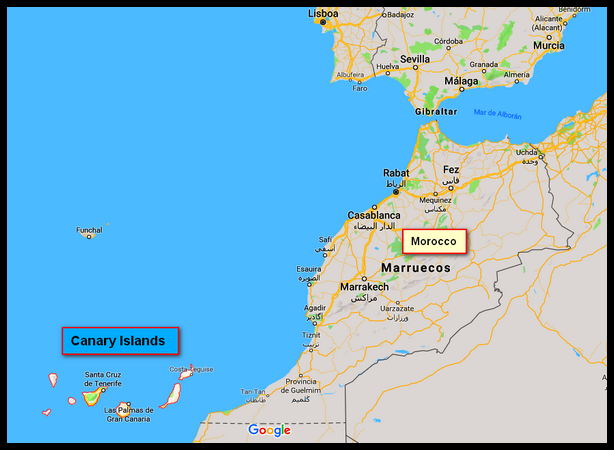 Introduction to the Canary Islands
Introduction to the Canary Islands
The Canary Islands are a group of seven rugged islands of volcanic origin situated out in the Atlantic Ocean off the NW coast of Africa. They are closest to Morocco, with the eastern-most islands located just 100 km / 60 miles offshore. Flights to/from Marrakech, Morocco take only two hours to the major islands (though most visitors fly to/from Europe and UK).
The seven islands are Tenerife, Gran Canaria, Lanzarote, Fuerteventura, El Hierro, La Palma and La Gomera. The two largest and most substantial in terms of size, population, economy, religious & political importance and tourism are Tenerife and Gran Canarias.
Despite their location, Canary Islands are part of Spain and have been since the Spanish took over the islands in the late 1400s, though the islands didn’t officially became part of Spain until 1821.
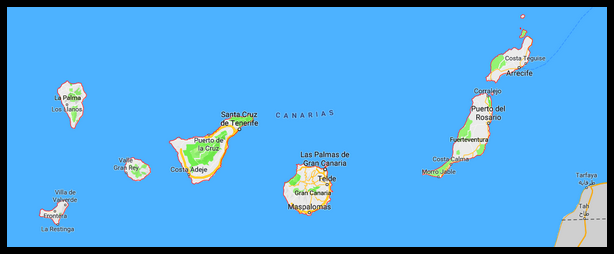 Not surprisingly, the main language is Spanish; the Catholic church rules; and the island’s substantial historic architecture consists primarily of various Spanish styles from the 15th-19th centuries, with influences from Italy, France, England and the Moors. However, there are also distinctive architectural features originating in the islands, including extensive use of volcanic stone and native pine, which makes the island’s historic towns & churches distinctive in the world.
Not surprisingly, the main language is Spanish; the Catholic church rules; and the island’s substantial historic architecture consists primarily of various Spanish styles from the 15th-19th centuries, with influences from Italy, France, England and the Moors. However, there are also distinctive architectural features originating in the islands, including extensive use of volcanic stone and native pine, which makes the island’s historic towns & churches distinctive in the world.
Starting in the 1980s, Canary Islands have been gradually becoming a major tourist destination. They’re particularly popular with British, Spanish and other Europeans.
The visitors all flock to the islands for fun in the sun at various beaches, which have developed into mass tourist attractions. Large resorts have developed at many of the island’s beaches, with huge international 5-star resorts, golf courses, theme parks, shopping malls, upscale restaurants and bars, strip joints and casinos.
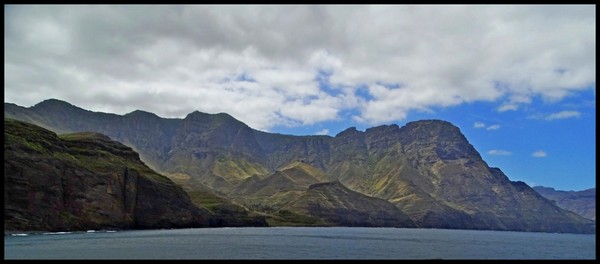
coastal cliffs – Gran Canaria
Reasons to Visit Canary Islands
As I just pointed out, most tourists visit the Canaries for luxury beach vacations and to escape the cold European winters.
However, the real attraction of the islands (in my opinion anyhow) is far away from the over-developed beach complexes.
All seven islands have incredible, diverse volcanic topography with amazing mountain roads & coastal cliffs to drive, unique plant life, interesting cave homes, plenty of volcanoes and even some undeveloped ‘au naturale’ beaches.
All that makes the Canaries a fantastic destination for nature lovers, like me, especially since they offer so much stunning, diverse scenery and lots of great hiking.
There are also several beautiful historic towns, a surprisingly fantastic art scene, excellent & diverse museums, unusually-constructed wine vineyards, coffee plantations, rum distilleries and a world-class cheese industry.
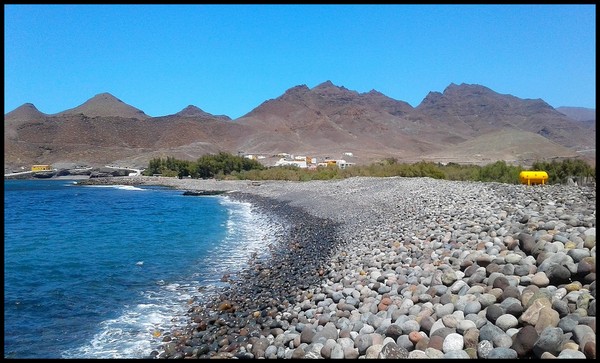
volcanic stone beach and coastal cliffs – Gran Canaria
Canary Islands Topography and Nature
While all they islands are volcanic in origin, and believed to be the tips of a much larger submerged volcanic chain, each island is surprisingly different in topography, plant & animal life and, to some extent, climate.
Tenerife, Gran Canaria and La Palma are all dominated by a massive central volcanic crater mountain, with steep & winding interior mountain roads, dramatic cliff-lined coasts and some flatter coastal areas with beaches. Tenerife supports a very lush, green region in the north, filled with pine & laurel forests and profusely blooming flowers and dense vegetation, while Gran Canaria is almost entirely dry & barren-looking.
The two eastern-most islands of Fuerteventura and Lanzarote are much flatter and drier, with large areas looking more like desert regions of Africa. Lanzarote is practically flat all over, with dozens of softened, weather-worn volcanoes peeking up from the plains.
Fuertevantura is also mostly flat, but has a mountainous central area. It is famed for having the archipelago’s most stunning beaches and a huge population of goats, from which the islanders make their famed goat cheeses.
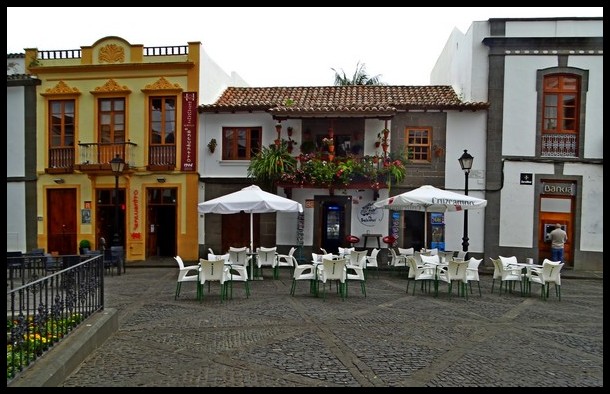
the pretty mountain town of Teror – Gran Canaria
Canary Islands History
The islands have a complex & intriguing history. The original habitats, Guanches, are believed to have originated from desert tribes in the Morocco area several thousand years ago, the main tribes being the Berbers, Mahghreb and Saharans.
They lived in caves, which were formed by volcanic lava pockets, and practiced fishing, agriculture & herding. Sadly, the Guanches were completely wiped out by the Spanish conquerors in the 1400s.
After Spanish conquest, the islands fell prey to attacks by rival countries, pirates and the slave trade from the late 1400s to the mid 1800s. Lanzarote, in particular, was repeatedly devastated by pirate attacks during those centuries.
Despite that, after the Spanish take over, various wealthy Europeans emigrated there over the centuries, particularly from Spain, Italy, France and England, all adding their cultural touches & influence.
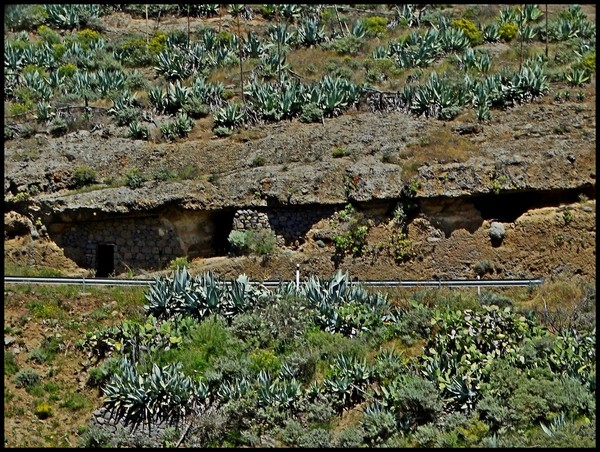
Cave houses
In the late 1800s, masses of islanders were left in dire poverty due to heavy taxation by Spain and the rugged farming life on the dry islands. This lead to massive emigrations from the Canaries in the 1800-1900s. Hundred of thousands of islanders relocated to Venezuela, Cuba and other Latin American countries.
The islands’ economy really only got turned around in the 1980s with the advent of mass tourism, as noted above. And now the Canary Islands are booming, especially Tenerife and Gran Canaria.
…and interesting aside:
Amazingly, to this day, some people in the Canaries still live in caves, though they’ve been modernized, especially in central Gran Canaria.
In addition, many fantastic luxurious modern houses have been created by artist/architects using existing caves and lava sink holes. These are found especially on Lanzarote Island, where the island’s famous artist, Cesar Manrique, created many fantastical private homes, cultural museums and large sculptures.
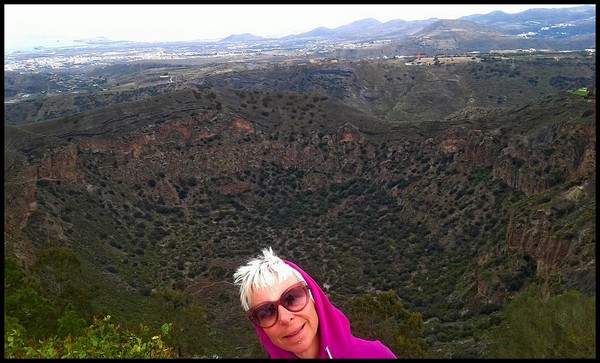
hiking at Caldera Bandama = Gran Canaria
My Visit to Canary Islands 2019
I’m just finishing up a one-month exploration of the Canaries. I’ve been able to visit three: Gran Canaria, Lanzarote and Tenerife. I explored most of the time with a friend so we rented a car on each island, which is really the only way to see many of the natural areas, particularly on Lanzarote, which has a less developed bus network.
As a result of exploring by car, I’ve been able to enjoy a lot of very diverse & stunning scenery; drive on many fantastic mountain and coastal roads; visit a few gorgeous towns and do a lot of hiking, particularly in various volcanic topographies.
As for hiking in volcanic terrain – I’ve circumnavigated the rim of several craters, scaled to the top of a couple volcanic peaks, climbed down inside craters, walked across rough surreal black lava fields, strolled around the base of massive volcanoes and hiked to the top of tall volcanic cliffs that plunge into the cold Atlantic.
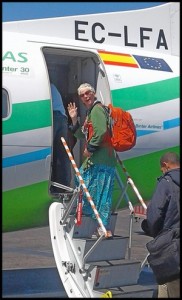
boarding plane in Marrakech to canary islands
Although I’ve had a great time and seen a lot of gorgeous scenery on the three islands, after I read more about La Palma, El Hierro and La Gomera, I’m not sure I selected the best islands for my visit! Of all the Canary Islands, those three are the least developed, most nature-oriented, and least crowded.
I inadvertently ended up visiting the Canary’s three most popular, tourist-laden islands. Dag.
However, that was primarily the result of my hotel review assignment. Given the high costs and my available time, I probably couldn’t have done it any differently. But I’m definitely interested in returning one day to explore the four islands I missed this year.
I’ll be writing separate articles detailing each of the three islands I explored: Tenerife, Gran Canaria and Lanzarote. I’ll also write an article describing the four islands I missed, based on my research for an assignment updating a Canary Islands guide.
So stayed tuned for more info about the gorgeous Canary Islands of Spain!
You might also enjoy:
My First Impressions of Morocco
20 Things I Love about Marrakech
=============================================












 Hi! I'm Lash, an American nomadic world traveler who's been traveling solo since 1998. I’m passionate about traveling the world nomadically and then sharing it all with you. I hope to inspire you to travel the world, to entertain you with tales from the road, and to help you reach your travel dreams. Welcome!
Hi! I'm Lash, an American nomadic world traveler who's been traveling solo since 1998. I’m passionate about traveling the world nomadically and then sharing it all with you. I hope to inspire you to travel the world, to entertain you with tales from the road, and to help you reach your travel dreams. Welcome! 




5 pings
Canary Islands – All About Lanzarote - LashWorldTour
2019/05/06 at 1:55 am (UTC 8) Link to this comment
[…] « Introduction to the Canary Islands […]
Canary Islands – El Hierro – La Palma – La Gomera – Fuerteventura - LashWorldTour
2019/05/14 at 8:55 pm (UTC 8) Link to this comment
[…] My Intro to the Canary Islands […]
Introduction to Montenegro
2019/07/14 at 3:03 pm (UTC 8) Link to this comment
[…] Introduction to the Canary Islands […]